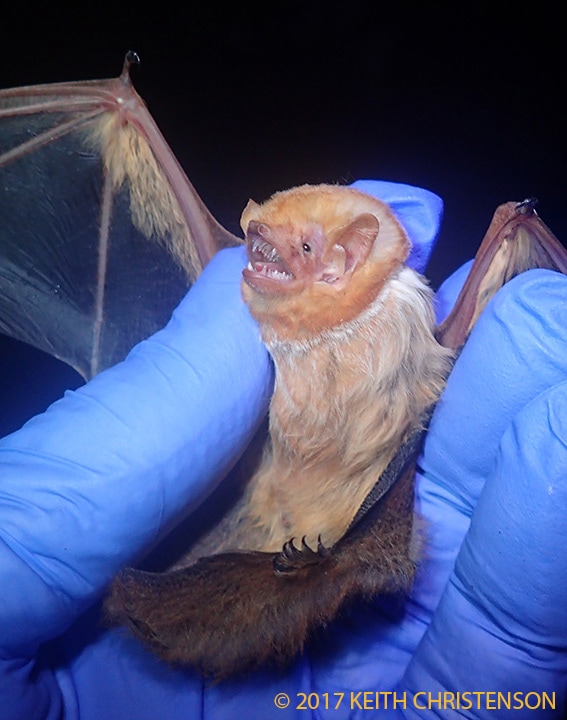I am using a photo here with the mouth open to show the teeth, which are exposed because the bat is likely unhappy about being caught in a net and then handled. I would be pretty irate if someone did this to me, so I can't blame the bat for seeming to be unhappy. And the teeth are plentiful and sharp with well-developed incisors for dealing with insect prey. There is a gap, which is hard to see here, between the upper canines that allows the bat to produce echolocation calls without teeth getting in the way. Inside the ears there is a large protuberance called the tragus which focuses the returns of these calls so that bats can fly and feed in total darkness. Spiffy adaptations to night feeding on insects.
And I have to state here that NO ONE should ever handle a bat without permits and precautions. These are protected animals that need permits to handle and any bat has some chance of rabies exposure which is fatal to humans. Just don't do it. Ever. If you want to see bats up close you really need to work with local wildlife professionals who capture bats and let them show you the animals.
Which brings me to the bright blue rubber gloves in the photo. These are nitrile gloves that we use, one pair per bat, to prevent spreading disease between bats. They are not for our protection, but for the bat's protection (all bat handlers are vaccinated for rabies with current medical clearance as well). There are things out there like White Nose Syndrome that kill bats, and we take enormous precautions when handling bats to not spread any disease between our captured bats.
So with the blue gloves explained, back to the bat. Here you can see one of the coolest adaptations of bats. Notice that the feet are, in general, opposite of human feet. Bat's knees are 180 degrees rotated from most any other mammal, allowing them to cling to a cave wall or similar and have their back exposed rather than their belly. I think this is one amazing adaptation to their lifestyle, and with this specific bat allows them to look like a deaf leaf on a tree with nearly perfect camouflage.
The fur of bats varies widely. The red bat has fur on its wings out to the wrist and fully on the membrane between the legs. Some bats have no fur in any of those places and may not even have a membrane between the legs. But for bats like the red bat that eat insects, a whole bunch of species will actually capture insect prey in the tail membrane and move it to the mouth instead of just trying to snap it in their jaws. Kind of like netting insects in the tail membrane, yet another very cool adaptation.
The last thing I will note is the eyes. All bats have eyes and none are blind. The expression "blind as a bat" is great but completely false since they all have eyes and many can echolocate even in light-free caves. But eye size and complexity varies greatly among bats. The red bats have relatively small eyes, while some bats have really big eyes. All adaptations to feeding regimes and needs of the bat species.
Just a little bat education which I haven't done enough of lately.

 RSS Feed
RSS Feed